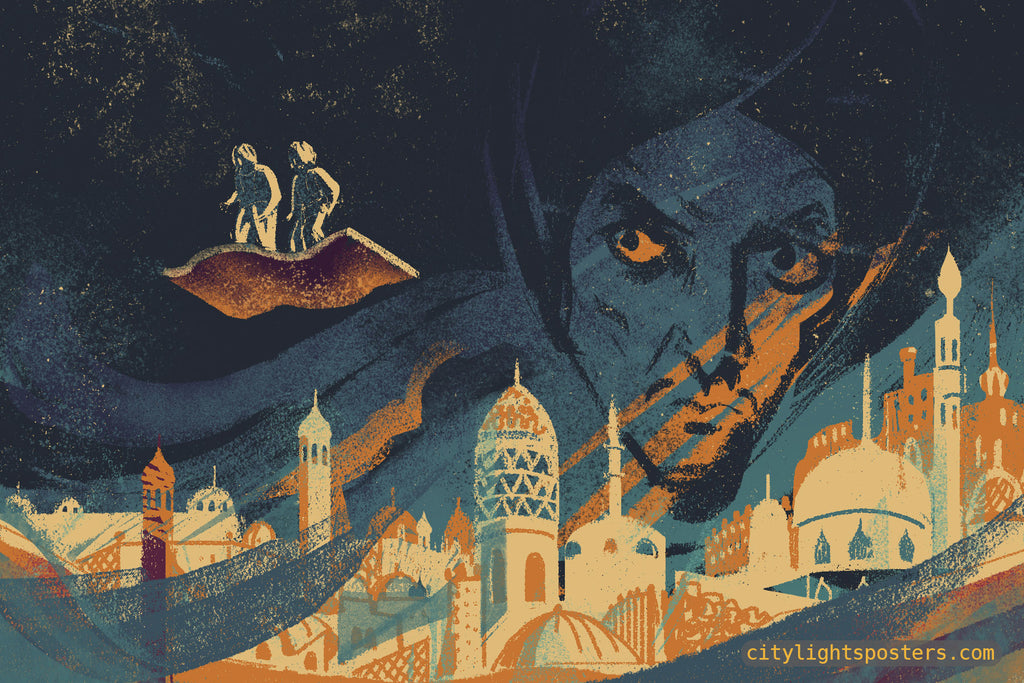Thief of Baghdad: Arabs in World Cinema

By Abboudi and Samer Abou Jaoude
This article first appeared in the Thief of Baghdad exhibition booklet. The exhibition is hosted by Dar El-Nimer, Beirut from 20 February to 25 May 2019. The exhibition comprises a series of film posters produced in the West between the 1910s and 1990s that highlight the perception of Arabs in Western cinema through films like A Thousand and One Nights, Sinbad, Cleopatra and Scheherazade. For more information on the exhibition, visit Dar El-Nimer’s website.
 |
LITTLE EGYPT: THE DISPERSION OF FANTASY
The general public’s Western perception towards Arabs, later referred to as the Western Arab perception, witnessed popular realization and public dispersion in the West and particularly in the United States, but this happened far before the emergence of commercial cinema. This example is narrated in Lisa Wynn’s book Pyramids and Nightclubs, which recounts the story of twelve female performers led by Farida Mazher, also known as Little Egypt, who performed at the Chicago World Fair in 1893 and were well received by the American audience. Soon after their American tour, the performers went adrift. Canadian Catherine Devine had become obsessed with the ‘Arab’ dance and changed her name to a more Arabic name, Aesha Wehbe, and kept on performing alone under the name of Little Egypt.
 |
Delvine’s claim to fame came in 1898, following a police raid at a fancy New York party, after hearing rumors that she was going to dance naked. This incident paved the way for shady dancers to use the name Little Egypt for popularity. Far from the public eye, Fairda Mazher filed claims against Catherine for stealing her name, as well as Metro Goldwyn Mayer for misinterpreting her in their 1936 movie The Great Ziegfeld, but Mazher died before any court trial.
This Arab fantasy was depicted in the 1951 comedy Little Egypt about a princess who seduces a wealthy American. This name was later incorporated into songs such as Little Egypt by the Coaters, also sung by Elvis Presley in the 1964 movie Roustabout.
INTERNATIONAL CINEMA: THE ARABS MAKE IT TO THE MOVIES
The cinema industry was dominant in Europe and America, however with World War I and the European involvement, the American film industry began to lead the market and distribute its movies worldwide, attracting a large number of artists, writers and directors. During this period, 700 films were produced a year, justifying why the general image of Arabs was dominantly present in American cinema.
As the film industry flourished, directors and producers aimed to create narratives which met the desires of the audience. Until then, they had resorted to books or popular culture stories, which were known on a global scale. The writings of Orientalists and travelers to the Arab world were able to engage different audiences. One of those successful films was The Sheik (1921), played by Rudolph Valentino. The movie inspired the shooting of around ninety movies centered around Arabs in the 1920s and produced in America.
 |
Amongst the audience, the general image of Arabs remained that of a barbaric man enveloped in violence and lust, mainly seen in the film of Beau Gest in its four releases of 1926, 1939, 1966 and 1982. In such movies particularly, the dry and empty desert is given much focus reflecting on a nomadic and dull landscape. In Desert Song (1929, 1943 and 1953), the fertile mountains of Morocco are depicted as barren and arid.
Those Western stereotype images transcend far from the Arab world’s reality. The reason for this is the directors’ attribution, who have formed their opinions of the Arab world through the readings of Western Orientalist books. The image of Arabs in international cinema raises complications on the level of criticism. Despite the subject’s diversity, one can observe some of the primary leading thoughts and images on which the Western Arab perception was conceived and later developed.
THE ARAB FANTASY
The Arab Fantasy’s image was intended to amaze the audience through creating a magical Arab land with hidden treasures and wonders, inhabited by magicians, seductive sirens, belly dancers, Sheikhs and gigantic mythical creatures.
In Thief of Baghdad (1924), which was reproduced three times in 1940, 1961 and 1978, the directors focused on flying carpets, wizards, magicians and exquisite lands far from social realities. The second adaptation produced by Alexander Korda starting in 1938 was filmed across two years between England and America. It included many special effects, such as a castle-sized genie, which helped garner universal appeal. Due to its wide success, it was re-released internationally in 1944, 1948, 1956, 1965, 1977 and 2000. With the success of the 1940s adaptation of Thief of Baghdad, the directors turned towards A Thousand and One Nights leading to the production of many American films such as Ali Baba and the Forty Thieves (1944); A Thousand and One Nights (1945); Sinbad the Sailor (1947); the Indian Aladdin and the Wonderful Lamp (1952); the French Ali Baba et les 40 Voleurs (1954); the French-Tunisian joint film Goha (1958) and other international films sharing this genre.


Thief of Baghdad, Spain, 1978 Re-release of 1940 film, 70 x 100 cm; Captain Sinbad, Denmark, 1961, 62 x 85 cm
 |
LAND OF WARS AND ESPIONAGE
After World War II and the return of cinematography in Europe, the Arab world was the main focus of a large number of films depicting fictional and non-fictional war events. These movies focused on the battles occurring on the Egyptian borders and in the Arab Maghreb between the English and Americans on one side and the Germans and Italians on the other, with the Arabs present on each side. Such films include Sahara (1943), Five Graves to Cairo (1943), Cairo Road (1951) and many other French and English films about the Foreign Legion in the Maghreb such as Outpost in Morocco (1949) and Ten Tall Men (1951).
With the beginning of the 1960s and the emergence of the wave of police and espionage films, many films, especially commercial ones, known as ‘Category B’ to Arabs, were filmed in countries such as Egypt, Lebanon and Tunisia. Such examples include Cairo (Egypt, 1963), 24 Hours to Kill (Lebanon, 1965) and Le Spie Uccidono a Beirut (Lebanon, 1965). A number of Arab actors from these movies included Faten Hamama, Samia Gamal, Jamil Rateb, Shakib Khoury and Ihsan Sadiq. It is believed that Omar Sharif’s participation in Lawrence of Arabia (1963) played a major role in his rise to international cinema.
 |
DEHUMANIZED ARABS
The establishment of Jewish settlements in Palestine, the partitioning of Palestine in 1948, the emergence of the ‘Israeli’ entity and the occupation of other Arab territories in 1967 played a new role in the Arab characterization, especially the Palestinian one, in international cinema.
In the 1970s, American and international film productions were often used to promote specific ideas about the Arabs in the minds of the viewers. It was not enough to ridicule and mock the Arab figure, but there was often an evident political endeavor to warn against Arabs, portraying ‘Israel’ as a developed state being attacked by the uncivilized Arabs. This is demonstrated in Black Sunday (1977), which became a model for many other movies portraying Arab terrorism. Network (1976) was the first movie to warn about wealthy Arabs seizing the American media limiting the freedom of the American press and taking over their stations. In his book Reel Bad Arabs, Jack Shaheen vividly documented how many movies vilified Arabs by depicting them as barbaric villains.
 |
Few Arab directors attempted to correct this image. They were unable to overpower the generally accepted stereotypes. Two examples, The Message (1976) and Lion of the Desert (1981) were both directed and produced by Syrian-American director Moustapha Al-Akkad. From the 1980s until 2000, other international directors depicted Arabs across the good-bad spectrum rather than the general evil Arab one. Examples can be seen in Hanna K. (1983), Three Kings (1999) and The 13th Warrior (1999). At the beginning of the 21st century, commercial violent films continued to present the image of Arabs as terrorists and safety threats. Moreover, Arabs were not the only ones vilified by Hollywood, but the Arab image took a more violent turn with the ‘Israeli’-Palestinian conflict.
Abboudi Abou Jaoude is a publisher and an avid collector of cultural and political posters. During his career and particularly since the late 1970s, Abou Jaoude went on to build a substantial and significant collection of vintage movie posters from the Arab world as well as numerous pieces of international and local movies. The first poster from the Thief of Baghdad collection, which he acquired as a teenager, was The 7th Voyage of Sinbad (1958). The collection accumulated to 550 original posters and 300 pictures and press books from around 20 countries.
Subscribe to our newsletter to receive the latest latest blog updates, poster releases, and special offers.
